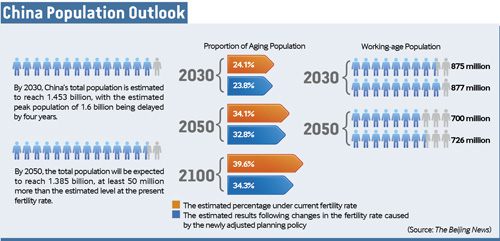|
Zhang Chewei, a demographic expert at the Chinese Academy of Social Sciences, believes easing the one-child restriction will have a positive effect in the long term. "Its advantages will begin to show in 15 years," Zhang said. "The proportion of the labor force to the whole population will change slowly. It will also help economic growth."
Liang Zhongtang, another demographer from the Shanghai Academy of Social Sciences, however, calls for more severe adjustments to the family planning policy. "The latest move was not enough," he said. "The ultimate goal should be eliminating the limits imposed by the government, leaving the decisions to families themselves."
"It is not possible to allow all couples to have two children at the present time," said Wang Pei'an, Vice Minister of the NHFPC. "It would lead to high volatility in the infant population, putting too much pressure on public services. While in the long term, it would result in continued growth in population and postponing of the population peak, which would have a negative impact on China's economic and social development."
Despite relaxed restrictions, Wang said that there will also be annual population planning to prevent large fluctuations.
According to Wang, China's food security and basic public resource planning are based on the estimated population for 2020 and the peak population in 2033, which are 1.43 billion and 1.5 billion, respectively.
Mao Qun'an, a spokesman for the NHFPC, echoed Wang by saying that family planning is part of the comprehensive policy of the Chinese Government, and official estimates have ruled out the possibility of a population surge as a result of the revisions.
Mao expects China to maintain a relatively low population growth over time.
Potential impact
Mao credited China's successful family planning policy to containing a potential population explosion. The country's birth rate dwindled from 33.4 per thousand in 1970 to 12.1 per thousand in 2012.
Without the policy, Mao estimated, China would have had to support a population of 1.7 to 1.8 billion, and per-capita availability of resources, including arable land, grain, forests, drinking water and energy, would be 20 percent less than what it is today.
At that rate, resources and environmental capacity would not have been able to support rapid economic development, Mao said.
The adoption of the family planning policy has been effective in setting the foundations for economic and social development, but the falling birthrate also has drawn the growth of the aging population into focus and led to a shrinking working-age population.
China's sixth national census in 2010 showed a fertility rate between 1.5 and 1.6, far below 2.1—the level needed to ensure a country's population is maintained at a constant value.
"Both higher and lower fertility rates could hinder the balanced development of the population and the social economy," said Guo Zhenwei, a family planning official with the NHFPC.
Figures from the NHFPC show that China's labor force decreased by over 3.4 million during 2012, marking the first "absolute decrease." The elderly population, meanwhile, keeps on growing with those aged 60 and above numbering nearly 200 million, 14.3 percent of the total, far ahead of the international norm of 10 percent. The figure is forecast to exceed one third of the population by 2050, in line with the previous family planning policy.
According to Yuan Xin, a professor of population studies at Nankai University, to ensure coordinated economic and social development, China should aim for a fertility rate of around 1.8.
"Family planning policy will be adjusted and improved step by step to promote a long-term balanced development for China's population," Yuan said. He predicted that China's nationwide fertility rate would return to 2 at the very most.
Mao said that there has been no uniform timetable for the implementation of the new birth policy nationwide yet, and it would be up to local authorities to decide when to put the change into effect according to their local population situation.
"First we have to amend current laws on family planning before we can enforce it. People will not have to wait too long," Mao said. "In areas where there is a high concentration of couples who are eligible under the new policy, those who are older and may have a limited time to have a second child will get permits first."
Email us at: yuanyuan@bjreview.com
 | 